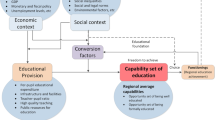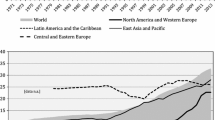Abstract
The great expansion of participation in higher education in Russia in the post-Soviet period was the layered and contradictory result of both conditions established in the Soviet period, and the structuring of reforms after the collapse of the Soviet Union in 1992. The Soviet government was strongly committed to the expansion of education across the country, and gender equality was achieved at that time. In the 1990s and 2000s enrolments more than doubled, though the growth of numbers has been reversed since 2008 because of demographic decline of the relevant age cohorts. Employing Trow’s analysis of the growth of higher education systems and Hirsch’s concept of positional goods, among other conceptual approaches, as well as statistical, national, and comparative survey data, this paper analyses social dynamics of the process of increasing participation and equalization of opportunity in Russia. The dramatic higher education expansion in Russia was largely associated with the positional value of higher education credentials, in a society in which the Soviet system of social status had been discontinued, and a new system of status was being built on the basis of post-Soviet rules (which are still evolving). Driven by family aspirations and resources, massification has largely rested on the part-privatisation of the costs of higher education, part of a neoliberal reform package common to the post-Soviet countries. However, higher education expansion has not brought about greater social equity. Expansion, fee-based financing and policy measures such as university excellence initiatives have tended to strengthen the institutional and social stratification of the higher education system, weakening social mobility and social equality.



Similar content being viewed by others
Notes
Total enrollment in tertiary education (ISCED-1997 5–8), regardless of age, expressed as a percentage of the total population of the 5-year age group following on from leaving secondary school (World Bank statistics) are also high: 77 % for tertiary A only (degrees and above) in 2010, though slipping to 69 % in 2012 (OECD Education at Glance 2014 2014).
The net entry rate for a specific age is obtained by dividing the number of first-time entrants of that age for each type of tertiary education by the total population in the corresponding age group. The sum of net entry rates is calculated by adding the rates for each year of age. The result represents an estimate of the probability that a young person will enter tertiary education in his/her lifetime if current age-specific entry rates continue (OECD statistics).
Incomplete higher education means holding a certificate of at least 2 years of study at a program leading to a higher education degree (specialist’s or bachelor’s, which are usually 5 and 4 years long, respectively, if full-time) or the completion of at least a half of a program leading to higher education degree (specialist’s or bachelor’s).
References
Altbach, P., Reisberg, L., & Rumbley, L. (2009). Trends in global higher education: Tracking an academic revolution. Paris: UNESCO.
Ayalon, H., & Shavit, Y. (2004). Educational reforms and inequalities in Israel: The MMI hypothesis revisited. Sociology of Education, 77, 103–120.
Bastedo, M., & Gumport, P. (2003). Access to what? Mission differentiation and academic stratification in U.S. public higher education. Higher Education, 46(3), 341–359.
Bessudnov, A. (2014). Parental occupational status and labour market outcomes in Russia. In National research university—higher school of economics basic research program. Working Papers Series: Sociology. WP BRP 36/SOC/2014.
Brennan, J., & Patel, K. (2011). Up market or down market: shopping for higher education in the UK. In P. N. Teixeira & D. D. Dill (Eds.), Public vices, private virtues: Assessing the effects of marketisation in higher education. Rotterdam: Sense Publishers.
Carnoy, M. (2011). As higher education expands, is it contributing to greater inequality? National Institute Economic Review, 215, R34.
Center for Institutional Research at the National Research University - Higher School of Economics data. www.cim.hse.ru.
Clancy, P. (2010). Measuring access and equity from a comparative perspective. In H. Eggins (Ed.), Access and equity. Comparative perspectives (pp. 69–102). Rotterdam: Sense Publishers.
Collins, R. (1979). The credential society: An historical sociology of education and stratification. New York: Academic Press.
Collins, R. (2002). Credential inflation and the future of universities. In S. Brint (Ed.), The future of the city of intellect: The changing American university (pp. 23–46). Redwood City: Stanford University Press.
Dubin, B., Gudkov, L., Levinson, A., Leonova, A. & Stuchevskaya, O. (2004). Dostupnost’ vysshego obrazovania: sotsial’nye i institutsional’nye aspekty (Accessibility of higher education: social and institutional aspects). In S. V. Shishkin (Ed.). Dostupnost’ vysshego obrazovania v Rossii (Accessibility of higher education in Russia). Moscow: Independent Institute for Social Policy.
Eggins, H. (Ed.). (2010). Access and equity. Comparative perspectives. Rotterdam: Sense Publishers.
Fourcade-Gourinchas, M., & Babb, S. (2002). The rebirth of the liberal creed: Paths to neoliberalism in four countries. American Journal of Sociology, 108(#3), 533–579.
Gasparishvili, A., & Toumanov, S. (2006). Moskovskii student sto let nazad i nyne (Moscow student 100 years ago and now). Otechestvennye zapiski, #3(30). http://www.strana-oz.ru/?numid=30&article=1274.
Gerber, T. P. (2000). Educational stratification in contemporary Russia: Stability and change in the face of economic and institutional crisis. Sociology of Education, 73(4), 219–246.
Gerber, T. P. (2007). Russia: Stratification in Postsecondary Educarion since the Second World War. In Y. Shavit, R. Arum, & A. Gamoran (Eds.), Stratification in higher education: A comparative study (pp. 294–320). Stanford, CA: Stanford University Press.
Gerber, T. P., & Cheung, S. Y. (2008). Horizontal stratification in postsecondary education: Forms, explanations, and implications. Annual Review of Sociology, 34, 299–318.
Gerber, T. P., & Hout, M. (1995). Educational stratification in Russia during the Soviet period. The American Journal of Sociology, 101(3), 611–660.
Gimpelson, V., & Kapeliushnikov, R. (Eds.) (2011). Rossisskii rabotnik: obrazovanie, professia, kvalifikatsia (Russian worker: Education, profession, qualification). Moscow: Higher School of Economics.
Haaristo H., Orr D., & Little B. (2012). EUROSTUDENT intelligence brief: Is higher education in Europe socially inclusive? Retrieved from http://www.eurostudent.eu/download_files/documents/IB_HE_Access_120112.pdf.
Heyneman, S. (2010). A comment on the changes in higher education in the former Soviet Union. European Education, 42(1), 76–87.
Hirsch, F. (1976). Social limits to growth. Cambridge: Harvard University Press.
Izyumov, A. (2010). Human costs of post-communist transition: Public policies and private response. Review of Social Economy, 68(1), 93–125.
Kember, D. (2010). Opening up the road to nowhere: Problems with the path to mass higher education in Hong Kong. Higher Education, 59(2), 167–179.
Konstantinovsky, D. (1999). Dinamika neravenstva (The dynamics of inequality). Moscow: Editoral URSS.
Konstantinovsky, D. (2008). Neravenstvo i obrazovanie (Inequality and education). Moscow.
Konstantinovsky, D., & Shubkin, V. (1977). Molodezh’ i obrazovanie (Youth and education). Moscow: Nauka.
Kuraev, A. (2014). Internationalization of higher education in Russia: Collapse or perpetuation of the Soviet system? A historical and conceptual study. Ph.D. dissertation. Boston College.
Kwiek, M. (2011). Creeping marketization: Where polish public and private higher education sectors meet. In R. Brown (Ed.), Higher education and the market (pp. 135–145). New York: Routledge.
Kwiek, M. (2014). Structural changes in the polish higher education system (1990–2010): A synthetic view. European Journal of Higher Education, 3#, 266–280.
Lucas, S. (2001). Effectively maintained inequality: Education transitions, track mobility, and social background effects. American Journal of Sociology, 106, 1642–1690.
Marginson, S. (1997). Markets in education. Sydney: Allen and Unwin.
Obrazovanie v RF 2012 (Education in RF 2012). (2012). Moscow: HSE.
Obrazovanie v RF 2014 (Education in RF 2014). (2014). Moscow: HSE.
OECD Education at Glance 2014 (2014). OECD.
Parry, G. (2012). Higher education in further education colleges. Perspectives: Policy and Practice in Higher Education, 16(4), 118–122.
Reimer, D., & Pollak, R. (2010). Educational expansion and its consequences for vertical and horizontal inequalities in access to higher education in West Germany. European Sociological Review, 26(4), 415–430.
Roschina, Y. (2006). Ch’i deti uchatsya v rossiiskikh elitnykh vuzakh? (Whose children are studying at elite Russian universities). Voprosy obrazovania, 1, 347–369.
Rossiiskiy statisticheskii ezhegodnik (Russian statistical year-book) (2013). Population by age groups. http://www.gks.ru/bgd/regl/b13_13/IssWWW.exe/Stg/d1/04-06.htm. Accessed 20 May 2014.
Routkevich, M. N. (2002). Sotsiologia obrazovania i molodezhi: Izbrannoe (1965–2002) [Sociology of education and youth: Selected papers (1965–2002)]. Moscow: Gardariki.
Shishkin, S. (Ed.). (2004). Dostupnost’ vysshego obrazovania v Rossii (Accessibility of higher education in Russia). Moscow: Independent Institute for Social Policy.
Smolentseva, A. (2007). The changing status of the Ph.D. degree in Russia: An academic attribute in the non-academic labor market. European Education, 39(3), 81–101.
Smolentseva, A. (2012). Access to higher education in the post-Soviet states: Between Soviet legacy and global challenges. Paper commissioned and presented at Salzburg global seminar, Oct 2–7, Salzburg, Austria. http://www.salzburgglobal.org/fileadmin/user_upload/Documents/2010-2019/2012/495/Session_Document_AccesstoHigherEducation_495.pdf.
Smolentseva, A. (2016). Transformations in the knowledge transmission mission of Russian universities: social vs economic instrumentalism. In D. M. Hoffman & J. Välimaa (Eds.), Re-becoming universities? Critical comparative reflections on higher education institutions in networked knowledge societies (pp. 169–200). Berlin: Springer.
Statistika obrazovania v RF v tsifrakh 2013 (Educational statistics in Russia 2013) (2013). NII Respublikanskiy tsentr expertizy: Moscow.
Strategia innovatsionnogo razvitia RF na period do 2020 goda (2011). Moscow.
Trow, M. (1973). Problems in the transition from elite to mass higher education. Carnegie Commission on Higher Education.
Ukhova, D. (2014). After equality: Inequality trends and policy responses in contemporary Russia. Oxfam discussion paper. May 2014.
UNESCO Institute for Statistics. (2011). July. http://siteresources.worldbank.org/EXTEDSTATS/Resources/3232763-1194387694925/TertiaryEd.zip.
Vasenina, I. & Sorokina, N. (2002). Vysshee obrazovanie v sovremennom mire (Higher education in contemporary world). In Chelovek i sovremennyi mir (Man and contemporary world) (pp. 418–440). Moscow: Infra.
Vserossiskaya perepis’naselenia 2010 (National census 2010). http://www.gks.ru/free_doc/new_site/perepis2010/croc/perepis_itogi1612.htm.
Wong, R. (2001). Egalitarianism versus social reproduction: Changes in educational stratification in five Eastern European countries. Paper for the research committee on social stratification and mobility (RC28) of the international sociological association, Mannheim, Germany, April 26–28. Accessed from: http://www.mzes.uni-mannheim.de/rc28/papers/Wong_isa.zip.
World bank education statistics. www.worldbank.org.
Acknowledgments
Support from the Basic Research Program of the National Research University Higher School of Economics is gratefully acknowledged. TZ-33 “Higher education system dynamics and institutional diversity in post-Soviet countries”.
Author information
Authors and Affiliations
Corresponding author
Rights and permissions
About this article
Cite this article
Smolentseva, A. Universal higher education and positional advantage: Soviet legacies and neoliberal transformations in Russia. High Educ 73, 209–226 (2017). https://doi.org/10.1007/s10734-016-0009-9
Published:
Issue Date:
DOI: https://doi.org/10.1007/s10734-016-0009-9




